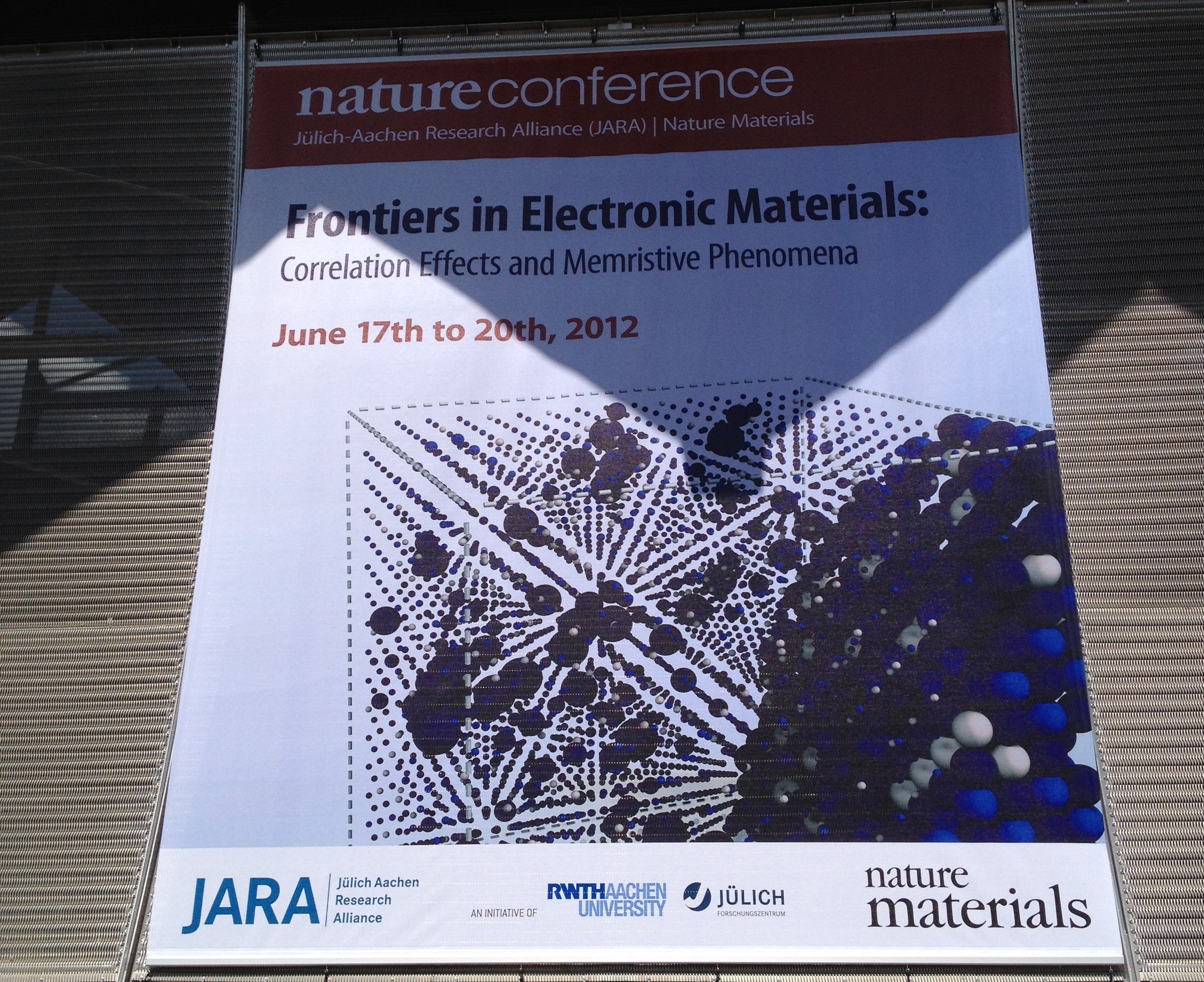 For the past weeks this blog has been more quiet than usual. Mostly, I was busy with a number of projects, including the co-organisation of a Nature Conference – ‘Frontiers in Electronic Materials: Correlation Effects and Memristive Phenomena‘. The conference took place in Aachen/Germany, and was organized in collaboration with the Jülich-Aachen Research Alliance (JARA) formed by the RWTH Aachen University and the Helmholtz research centre in Jülich – who did a great job in getting this meeting off the ground. Rainer Waser in particular dedicated a tremendous amount of work to the conference. And with close to 600 attendees, the popularity of the conference certainly exceeded all our expectations.
For the past weeks this blog has been more quiet than usual. Mostly, I was busy with a number of projects, including the co-organisation of a Nature Conference – ‘Frontiers in Electronic Materials: Correlation Effects and Memristive Phenomena‘. The conference took place in Aachen/Germany, and was organized in collaboration with the Jülich-Aachen Research Alliance (JARA) formed by the RWTH Aachen University and the Helmholtz research centre in Jülich – who did a great job in getting this meeting off the ground. Rainer Waser in particular dedicated a tremendous amount of work to the conference. And with close to 600 attendees, the popularity of the conference certainly exceeded all our expectations.
I do not intend to summarize all the interesting talks at the conference here. Instead, I like to focus on two aspects that I think contributed in particular to the success of the conference, and that could be of interest also to those that couldn’t attend the meeting. They’re related to the scope of the conference and its organisation.
Ionic versus electronic effects
With a strong focus on condensed matter physics and electronic materials, there naturally was a lot of effort on electronic effects. After all, the transistor itself is a device based on the transport of electrons. But as Joachim Maier said in his invited conference presentation: “don’t forget about the big guys”. That’s of course because crystals are not only made of electrons, but also ions – electrically charged atoms.
These ions are important for a number of electrochemical applications. Batteries are a good example, such as the rechargeable lithium-ion batteries. Yet the interaction of ions and electrons is of increasing relevance for electronics applications as well. In data storage so-called resistive switching random access memory ReRAM (or memristors) is in many instances based ionic effects controlling the electron flow through a device and to store information in this way. Another example is spin electronics, where the interaction of an electron’s magnetic property, its spin, with that of atoms can also be used for novel electronic effects.
It is quite clear that a lot can be learned at the interface between condensed matter physics and electrochemistry. The movement of ions across a crystal can be of relevance to several fields. And it was refreshing to see scientists of different backgrounds discussing the interaction of electronic and ionic effects in materials. There is a lot of great science still to be discovered in this area.
Introducing nanosessions

The Aachen Dome, venue of an organ concert for conference attendees.
From a logistic aspect this conference was also unique. The main conference sessions featured only about 30 invited speakers, mainly in a single session for all attendees. The point there was that these invited talks by leading researchers lasted 45 minutes each, including generous time for discussion. All speakers made a considerable effort to present a good introduction to their topic as well as presenting their latest research results. At the same time, we wanted to create a forum to discuss research fields in a smaller setting. And that’s where we came up with the idea of nanosessions, which were typically held prior to the poster session. So what are these nanosessions? Here an excerpt from the conference web site:
A Nanosession will open with an Invited Kick-Off talk of 20 min (including 5 min of discussion), followed by oral presentation of (four to six) posters of 10 min (including 3 min of discussion). At the close, there will be another 20 min for general discussions. The Nanosession will be guided by a session chairperson.
There will be approximately 10 to 20 people attending each nanosession. Assuming an average of two authors per presentation, we will have 8 to 12 participants who contribute to the nanosession. We estimate ten people in addition as audience
Basically, we grouped a couple of posters together and selected some of these for oral talks. The audience was indeed about 10 to 20 participants, which is about the same amount of people you often get in some of the smaller sessions at large conferences. And the idea worked. Good discussions were going on – so much so that on the second day of the conference we had to move the different nanosessions a bit further apart in the room so that the noise level of the discussion in one session wouldn’t disturb the discussions of another.
The concept seems to have worked very well, and might be a good way of giving a bit more prominence to a poster session, and to get a good discussion going between researchers working on a specific topic. The feedback we received on these nanosesssions was great and I certainly would recommend others organising a meeting to consider the format!
Organising such a major conference is always very time-consuming, and requires months of preparation – in this case about two years. In the end, in my experience such efforts are well spent as it is great to see such a large number of participants at the meeting, doing what this is all about: living science.


August 28, 2013 at 09:19
I was there! Great conference! Thanks for co-organizing!
August 28, 2013 at 15:53
Thanks a lot Zeila. I am glad you enjoyed the conference!